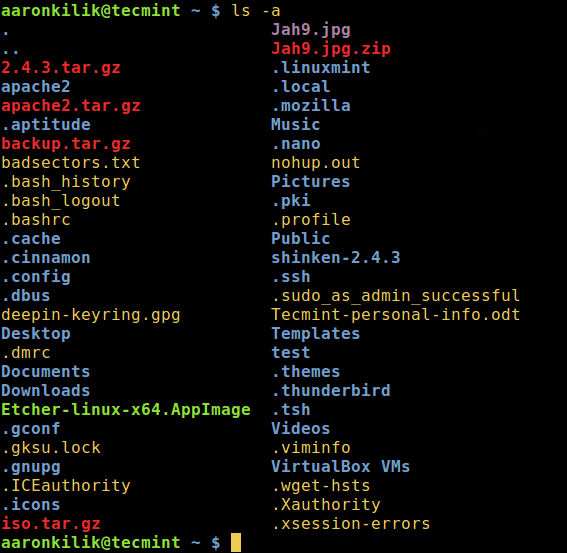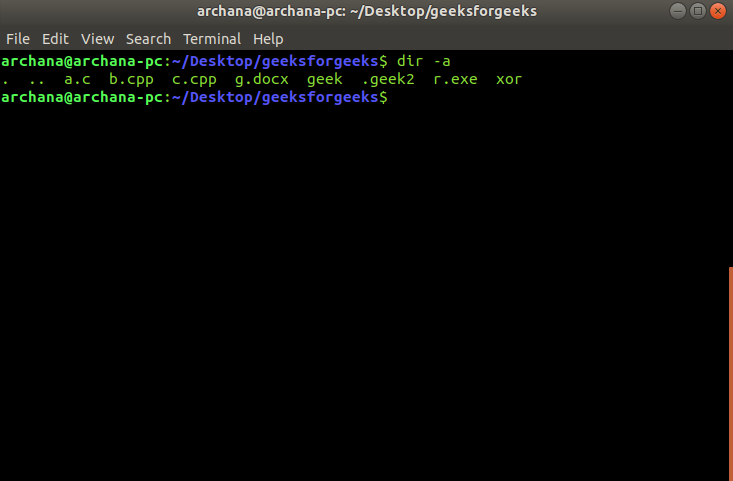
- #List directory contents that start with in linux how to#
- #List directory contents that start with in linux install#
- #List directory contents that start with in linux full#
You can also print the size of each file in bytes along with the name using the -s option. Print File Type and Permissions with Ownerĩ. You can combine the -p, -u and -g options to do a long listing similar to ls -l command. Besides, to print the username (or UID if no username is available), of each file, use the -u option, and the -g option prints the group name (or GID if no group name is available).

There are also some useful file options supported by tree such as -p which prints the file type and permissions for each file in a similar way as the ls -l command. You can also tell the tree to prune empty directories from the output by adding the -prune option, as shown. In this example, the command will only list files that match cata*, so files such as Catalina.sh, catalina.bat, etc. To display only those files that match the wild-card pattern, use the -P flag and specify your pattern. Here is another example about setting maximum display depth of the directory tree to 3. For example, if you want a depth of 2, run the following command. You can specify the maximum display depth of the directory tree using the -L option.

#List directory contents that start with in linux full#
If used together with the -f option, the tree will print the full directory path as shown. You can also instruct tree to only print the subdirectories minus the files in them using the -d option. To list the directory contents with the full path prefix for each sub-directory and file, use the -f as shown. You can enable the printing of hidden files using the -a flag. It will display the contents of the working directory recursively showing sub-directories and files, and a summary of the total number of sub-directories and files. Remember to invoke sudo to run the tree in a directory that requires root user access permissions. To list directory content in a tree-like format, navigate to the directory you want and run tree command without any options or arguments as follows. Once installed, you can proceed further to learn the tree command usage with examples as shown below.ġ.
#List directory contents that start with in linux install#
# dnf install tree #Fedora 22+ and /RHEL/CentOS 8 The tree command is available on all if not most Linux distributions, however, if you do not have it installed by default, use your default package manager to install it as shown.
#List directory contents that start with in linux how to#
In this short article, we will show how to use the tree command with examples to recursively list the contents of a directory on a Linux system. It features various options for output manipulation, from file options, sorting options, to graphics options, and support for output in XML, JSON and HTML formats. The tree program is available in Unix and Unix-like systems such as Linux, as well as DOS, Windows, and many other operating systems. Read Also: dutree – A CLI Tool to Analyze Disk Usage in Coloured Output It outputs the directory paths and files in each sub-directory and a summary of a total number of sub-directories and files. How to check if a directory exists in Linux One can check if a directory exists in a Linux shell script using the following syntax: & echo “Directory /path/dir/ exists.” You can use ! to check if a directory does not exists on Unix: & echo “Directory /dir1/ DOES NOT exists.”.The tree is a tiny, cross-platform command-line program used to recursively list or display the content of a directory in a tree-like format. find /home -user randomperson-mtime 6 -iname “.db”. Look for an empty file inside the current directory. jpg files in the /home and directories below it. If you need to know how to find a file in Linux called thisfile. How do I find a file path in Linux?īasic Examples find. To display detailed information about a directory, type the following: ls -d -l. dot (.) To display detailed information, type the following: ls -l chap1. See the following examples: To list all files in the current directory, type the following: ls -a This lists all files, including. How do I get a list of files in a directory? When invoked without any arguments, ls lists the files in the current working directory. ls is specified by POSIX and the Single UNIX Specification. In computing, ls is a command to list computer files in Unix and Unix-like operating systems.

How do I get a list of files in a directory?.What is the ls option that prints the author of a file Unix and Unix-like operating systems?.What command is used in Unix OS to list the files?.How do I list the contents of a directory in Linux?.What is the command to list the contents of a directory in Unix?.


 0 kommentar(er)
0 kommentar(er)
